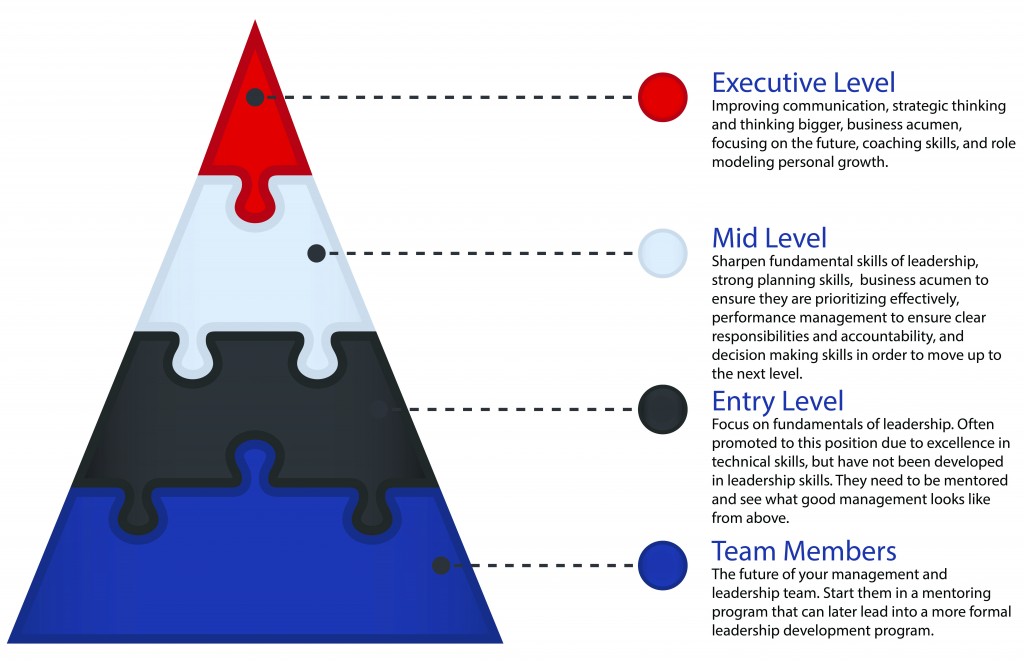Your leadership pipeline defines your ability to remain competitive in the marketplace into the future.
 Do you have a plan for how you will fill key management and leadership positions in your organization? This is a critical area of concern for many companies worldwide as engagement and retention becomes an ever more difficult challenge. Company leaders are increasingly becoming aware of the leadership skills gap in their teams. So what can be done about it?
Do you have a plan for how you will fill key management and leadership positions in your organization? This is a critical area of concern for many companies worldwide as engagement and retention becomes an ever more difficult challenge. Company leaders are increasingly becoming aware of the leadership skills gap in their teams. So what can be done about it?
What Is A Leadership Pipeline?
Much like a sales pipeline, a Click to Tweet: A leadership pipeline is your database of employees at various stages of becoming leadership-ready. As your company grows or transitions occur, do you have a pipeline of people to tap into that you can promote or move cross functionally to fill the gaps?
Many company leaders and human resources managers recognize that their organization’s leadership skills gap continues to grow, but most do not have a plan for how they will solve this critical issue. Focusing on your leadership pipeline will help you begin to determine where you currently have talent that can fill gaps and what areas you need to either develop skills or hire additional talent.
 How Strong Is Your Pipeline?
How Strong Is Your Pipeline?
How do you know whether or not you have a strong leadership pipeline? It’s fairly simple. If you have at least two levels of employees that are either ready to fill management and leadership roles now or have the potential to in the future with development, then you have sufficiently managed your leadership pipeline and you are in good shape.
Think about a scenario in which one of your key managers gets in an accident and is suddenly no longer able to take care of their responsibilities at the office. Who on your team can take their place at a moment’s notice? Who would be able to fill it, but may need six months or so of training and development to become at least as effective as the person they are replacing? How about a year? How about people on your team who will be prime for promotion in three to five years?
Segmenting your pipeline for all key positions by ready now, ready in one year, and ready 2 – 3 years will help you understand your depth and strength of your pipeline. Starting on structured annual development plans for your leaders will ensure they are ready and stay engaged.
Why Is A Leadership Pipeline Important?
 You’re perhaps wondering at this point why a leadership pipeline is important to you. So what if you don’t have someone who can take over? You can just hire someone, right?
You’re perhaps wondering at this point why a leadership pipeline is important to you. So what if you don’t have someone who can take over? You can just hire someone, right?
Wrong. There are certainly times when hiring new talent is advantageous and necessary. However, generally, it is typically less efficient to have to hire, onboard, and train a new manager or leader than it is to have a plan for developing your team over the long run. For example, replacing a salaried mid-range position can cost your company 20% of that person’s annual salary. Cost of human capital replacement studies go further to indicate a sharp increase when you need to replace a highly educated, executive-level position – up to 213%! These costs include a number of areas beyond just the cost of recruitment. You also need to consider training and onboarding, decreased engagement rates and lowered morale of those left behind, and the cost of lost productivity.
Focusing your efforts on developing and mentoring your team to build a strong leadership pipeline pays dividends for the bottom line of your company. Companies that invest in leadership development and mentoring programs enjoy higher employee engagement and retention rates. They are better positioned to leverage changing market conditions and have a much stronger market position overall.
Click to Tweet: Developing depth in your leadership pipeline does not happen overnight. It is a process that you need to map out and identify what strength in leadership means to your organization. Practical leadership programs focused on developing and growing your people will not only strengthen your pipeline, but will also improve retention, motivation, and productivity – generating far greater ROI for your bottom line than any other capital investment in your portfolio.





